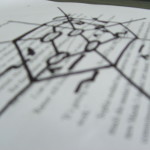 A character’s quest lies at the heart of any story, with their journey of change driving the plot as they face obstacles to achieving their ultimate desire. One thing that will undermine any character we write is a lack of consistency and a lack of believability. But ever since a recent family holiday in the ‘Land of the Long White Cloud’, there’s something else I’ve been considering relating to character development.
A character’s quest lies at the heart of any story, with their journey of change driving the plot as they face obstacles to achieving their ultimate desire. One thing that will undermine any character we write is a lack of consistency and a lack of believability. But ever since a recent family holiday in the ‘Land of the Long White Cloud’, there’s something else I’ve been considering relating to character development.
I think most of us are aware that people don’t behave in the way they do for no reason. We all have a history that predisposes us to certain behavioural patterns, deeply embedded in our thought processes and emotions. For example, children who’ve experienced trauma often, in turn, behave in ways that are unhealthy. Trauma makes as much of a wound on the brain as a physical injury. Even experiences that, to an adult, might seem inconsequential, can profoundly affected a child’s (and ultimately adult’s) behaviour and way of perceiving life. It stands to reason that these types of pain-based behaviours can be difficult to manage, but once identified, the brain can be ‘rewired’ over time by making different choices. Each positive choice makes a small change in the brain. And small changes, over time, make big ones.
Something I find frustrating as a reader is when a character whose entire life has been dictated by negative behaviours, suddenly changes, and then the story is resolved. Now, I’m not denying people can experience profound shifts in thinking over short periods of time, or even significant emotional healing, but more often than not, there’s a dogged grappling with pain-based patterns over time, before the positive choices outweigh the negative wiring of the past.
Just as a child can be damaged emotionally or mentally by being forced to grow up too fast, whether that be through exposure to adult concepts too early or, as mentioned above, through trauma, so our characters can come across as weak and untrustworthy if they change too fast, or without appropriate context and conditions justifying that change.
But how does this relate to our holiday in NZ? While touring, we visited a Redwood forest. The redwood seed had been brought over from America to grow trees to produce wood for use in construction and other such applications. Unfortunately, the NZ climate wasn’t the same as that from which the trees were brought. The trees grew too fast, leaving the inner core soft and unusable for the purpose it was intended.
Like those magnificent redwood trees, a character can be fleshed out to look every bit the part they’ve been developed to play in a story, but if they don’t go through challenge- or condition-appropriate growth, a reader won’t buy it. I think you’ll agree, there’s something about a character’s inner struggle that builds convincing inner strength, developing rapport with a reader. I do love stories where characters rise above overwhelming odds, but let’s ensure we give our literary heroes opportunity to develop sufficient core strength to make the distance.
